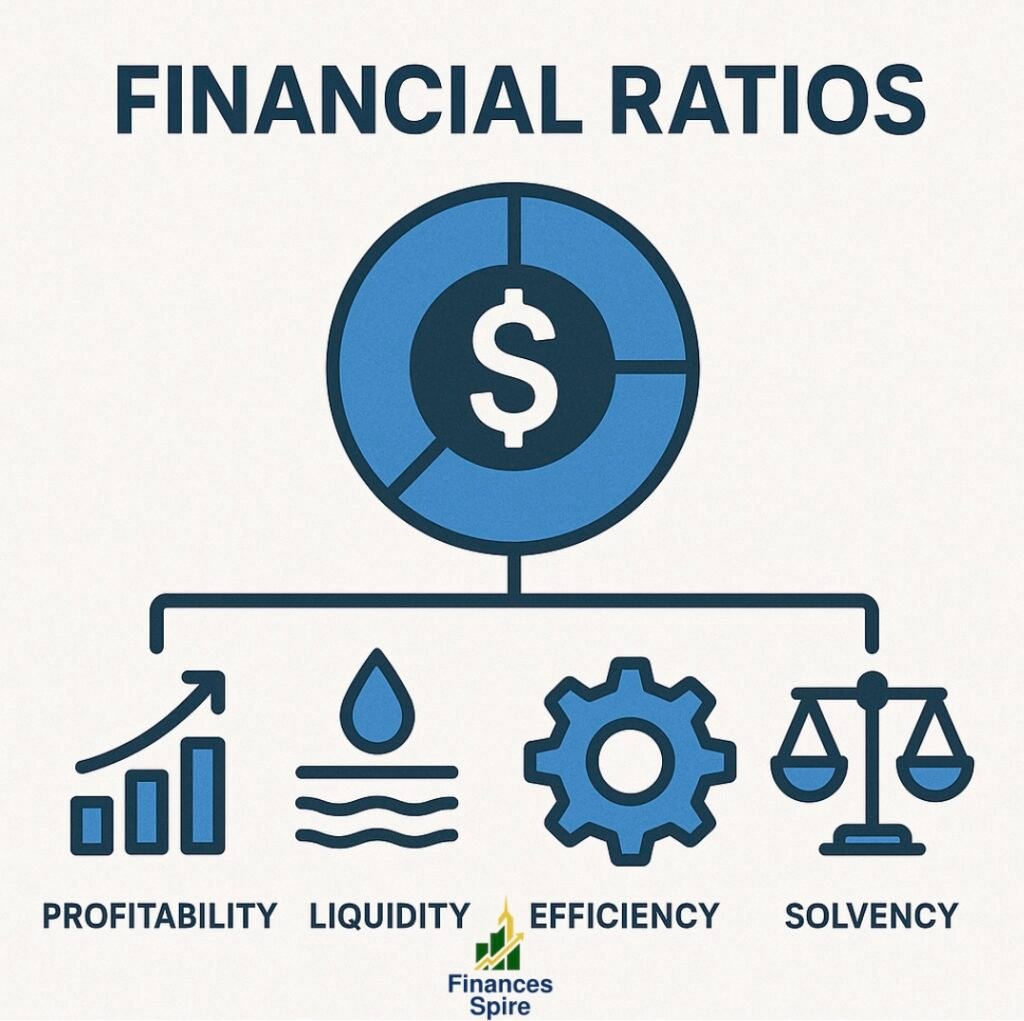Running a business without tracking financial ratios is like sailing a ship without a compass. Financial ratios are essential tools that give you a clear picture of your company’s performance, helping you make smarter decisions, attract investors, and stay ahead of competitors.
In this guide, we’ll explore the top 10 financial ratios every business should track — with real examples so you can apply them immediately.
📌 Why Financial Ratios Matter for Businesses
- Measure profitability and efficiency
- Understand liquidity and solvency
- Compare performance across time and with competitors
- Support better decision-making and planning
Pro Tip: If you want to ensure your company stays financially healthy, monitoring these ratios regularly is non-negotiable.
1. Current Ratio – Liquidity at a Glance
Formula: Current Assets ÷ Current Liabilities
Meaning: Shows whether your business can cover short-term obligations with short-term assets.
Example: $200,000 ÷ $100,000 = 2.0. You have $2 for every $1 of short-term debt.
Benchmark: Above 1.5 is considered safe.
2. Quick Ratio (Acid-Test) – The Stricter Liquidity Test
Formula: (Current Assets – Inventory) ÷ Current Liabilities
Meaning: Excludes inventory, offering a stricter view of liquidity.
Example: (200,000 – 50,000) ÷ 100,000 = 1.5
Benchmark: Above 1 is healthy.
3. Debt-to-Equity Ratio – How Much Risk Are You Taking?
Formula: Total Debt ÷ Shareholders’ Equity
Meaning: Shows how much debt your business uses compared to equity.
Example: 500,000 ÷ 1,000,000 = 0.5
Benchmark: Stay below 1 for safer operations.
4. Gross Profit Margin – Efficiency in Production
Formula: (Revenue – COGS) ÷ Revenue × 100
Meaning: Measures efficiency in production and sales.
Example: (1,000,000 – 600,000) ÷ 1,000,000 × 100 = 40%
5. Net Profit Margin – The Bottom Line
Formula: Net Profit ÷ Revenue × 100
Meaning: Shows the percentage of profit after all expenses.
Example: 200,000 ÷ 1,000,000 × 100 = 20%
6. Return on Assets (ROA) – Asset Efficiency
Formula: Net Income ÷ Total Assets × 100
Example: 150,000 ÷ 1,000,000 × 100 = 15%
Benchmark: Above 10% is typically good.
7. Return on Equity (ROE) – Owners’ Profitability
Formula: Net Income ÷ Shareholders’ Equity × 100
Example: 200,000 ÷ 800,000 × 100 = 25%
8. Inventory Turnover Ratio – Moving Stock Efficiently
Formula: COGS ÷ Average Inventory
Example: 600,000 ÷ 100,000 = 6 times per year
Benchmark: Higher turnover = stronger sales.
9. Accounts Receivable Turnover – Getting Paid Faster
Formula: Net Credit Sales ÷ Average Accounts Receivable
Example: 500,000 ÷ 50,000 = 10 times
10. Operating Cash Flow Ratio – Liquidity Beyond Paper Profits
Formula: Operating Cash Flow ÷ Current Liabilities
Example: 150,000 ÷ 100,000 = 1.5
✅ Final Thoughts
Monitoring these 10 financial ratios gives you a 360° view of your business’s financial health. From profitability to liquidity and efficiency, these tools help you make informed decisions, attract investors, and grow sustainably.
Pro Tip: Track them quarterly or monthly for better insights.
📈 Next Step for You
👉 Want to automate ratio calculations and monitor your financial health with ease? Check out our Smart Auto-Investing Spreadsheet and other digital finance tools.
🔎 Suggested Reading
- Top 5 Mistakes to Avoid in Budgeting Your Monthly Salary
- How to Save $10,000 in a Year – Proven Strategies That Actually Work
Top 10 Financial Ratios Every Business Should Track (With Real Examples)
Running a business without tracking financial ratios is like sailing a ship without a compass. Financial ratios are essential tools that give you a clear picture of your company’s performance, helping you make smarter decisions, attract investors, and stay ahead of competitors.
In this guide, we’ll explore the top 10 financial ratios every business should track — with real examples so you can apply them immediately.
📌 Why Financial Ratios Matter for Businesses
- Measure profitability and efficiency
- Understand liquidity and solvency
- Compare performance across time and with competitors
- Support better decision-making and planning
Pro Tip: If you want to ensure your company stays financially healthy, monitoring these ratios regularly is non-negotiable.
1. Current Ratio – Liquidity at a Glance
Formula: Current Assets ÷ Current Liabilities
Meaning: Shows whether your business can cover short-term obligations with short-term assets.
Example: $200,000 ÷ $100,000 = 2.0. You have $2 for every $1 of short-term debt.
Benchmark: Above 1.5 is considered safe.
2. Quick Ratio (Acid-Test) – The Stricter Liquidity Test
Formula: (Current Assets – Inventory) ÷ Current Liabilities
Meaning: Excludes inventory, offering a stricter view of liquidity.
Example: (200,000 – 50,000) ÷ 100,000 = 1.5
Benchmark: Above 1 is healthy.
3. Debt-to-Equity Ratio – How Much Risk Are You Taking?
Formula: Total Debt ÷ Shareholders’ Equity
Meaning: Shows how much debt your business uses compared to equity.
Example: 500,000 ÷ 1,000,000 = 0.5
Benchmark: Stay below 1 for safer operations.
4. Gross Profit Margin – Efficiency in Production
Formula: (Revenue – COGS) ÷ Revenue × 100
Meaning: Measures efficiency in production and sales.
Example: (1,000,000 – 600,000) ÷ 1,000,000 × 100 = 40%
5. Net Profit Margin – The Bottom Line
Formula: Net Profit ÷ Revenue × 100
Meaning: Shows the percentage of profit after all expenses.
Example: 200,000 ÷ 1,000,000 × 100 = 20%
6. Return on Assets (ROA) – Asset Efficiency
Formula: Net Income ÷ Total Assets × 100
Example: 150,000 ÷ 1,000,000 × 100 = 15%
Benchmark: Above 10% is typically good.
7. Return on Equity (ROE) – Owners’ Profitability
Formula: Net Income ÷ Shareholders’ Equity × 100
Example: 200,000 ÷ 800,000 × 100 = 25%
8. Inventory Turnover Ratio – Moving Stock Efficiently
Formula: COGS ÷ Average Inventory
Example: 600,000 ÷ 100,000 = 6 times per year
Benchmark: Higher turnover = stronger sales.
9. Accounts Receivable Turnover – Getting Paid Faster
Formula: Net Credit Sales ÷ Average Accounts Receivable
Example: 500,000 ÷ 50,000 = 10 times
10. Operating Cash Flow Ratio – Liquidity Beyond Paper Profits
Formula: Operating Cash Flow ÷ Current Liabilities
Example: 150,000 ÷ 100,000 = 1.5
✅ Final Thoughts
Monitoring these 10 financial ratios gives you a 360° view of your business’s financial health. From profitability to liquidity and efficiency, these tools help you make informed decisions, attract investors, and grow sustainably.
Pro Tip: Track them quarterly or monthly for better insights.
📈 Next Step for You
👉 Want to automate ratio calculations and monitor your financial health with ease? Check out our Smart Auto-Investing Spreadsheet and other digital finance tools.


